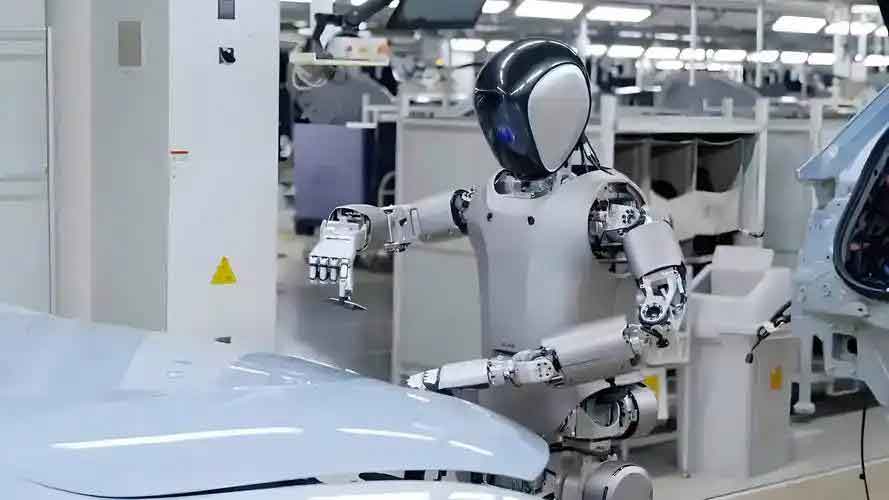As an observer of technological evolution, I have witnessed the rapid ascent of humanoid robots as a pivotal force in global innovation. The humanoid robot represents not merely a product but a platform-level ecosystem, integrating advanced AI, machine vision, and manufacturing prowess. In recent years, the humanoid robot has transitioned from theoretical concepts to tangible applications, driven by breakthroughs in embodied intelligence and multi-domain integrations. This shift underscores the humanoid robot’s role in shaping future industries, from智能制造 to daily services, making it a focal point of international tech competition.
The development of humanoid robots hinges on several core technologies, including autonomous navigation, task scheduling, and energy management. For instance, the efficiency of a humanoid robot in industrial settings can be modeled using performance metrics. Consider the following formula for task completion rate: $$ R_t = \frac{N_c}{T_t} $$ where \( R_t \) is the task completion rate, \( N_c \) is the number of tasks completed, and \( T_t \) is the total time taken. This highlights how humanoid robots optimize operations in real-world scenarios, such as assembly lines or logistics hubs.

In industrial applications, humanoid robots demonstrate remarkable versatility. They handle tasks like sorting,搬运, and precision assembly, often outperforming human labor in consistency and endurance. The humanoid robot’s ability to learn from data积累 enables continuous improvement. For example, in a smart factory, a humanoid robot might accumulate over 700 hours of operational data, refining its algorithms through machine learning. The following table summarizes key performance indicators for humanoid robots in manufacturing environments:
| Metric | Value | Unit |
|---|---|---|
| Average Task Completion Time | 3.5 | minutes |
| Energy Consumption per Cycle | 0.8 | kWh |
| Uptime Efficiency | 95 | % |
| Data Processing Speed | 150 | MB/s |
Moreover, the humanoid robot embodies the convergence of AI and physical systems. Embodied intelligence, a hallmark of the humanoid robot, allows it to interact dynamically with environments. This can be expressed through control theory equations, such as: $$ \dot{x} = A x + B u $$ where \( x \) represents the state vector of the humanoid robot, \( A \) and \( B \) are matrices defining system dynamics, and \( u \) is the control input. Such models facilitate the deployment of humanoid robots in complex tasks, from collaborative work in factories to autonomous navigation in warehouses.
The global market for humanoid robots is expanding exponentially, with projections indicating substantial growth. In 2025, the embodied intelligence sector alone is expected to reach billions in value, with humanoid robots capturing a significant share. This surge is fueled by investments in AI infrastructure and the humanoid robot’s adaptability across sectors. The table below outlines estimated market sizes and growth rates for humanoid robots in key regions:
| Region | Projected Market Size (2025) | Annual Growth Rate (%) |
|---|---|---|
| Asia-Pacific | $5.2B | 30 |
| North America | $4.1B | 25 |
| Europe | $3.5B | 22 |
Capital influx into humanoid robot ventures has been dramatic, with numerous startups and established firms securing funding to accelerate R&D. The humanoid robot’s potential as a general-purpose AI载体 attracts investors, driving innovation in hardware and software. For instance,融资 rounds in early 2025 exceeded $600 million for over 50 companies focused on humanoid robot technologies. This financial backing supports the humanoid robot’s evolution from prototype to mass deployment, particularly in commercial and industrial settings.
Technological milestones, such as hot-swappable battery systems, enhance the humanoid robot’s operational continuity. The energy autonomy of a humanoid robot can be quantified as: $$ E_a = \frac{T_w}{C_b} $$ where \( E_a \) is energy autonomy in hours, \( T_w \) is total work time, and \( C_b \) is battery capacity. Innovations like 3-minute autonomous recharging enable humanoid robots to function uninterrupted, a critical advantage in high-demand environments like automotive plants or healthcare facilities.
In terms of international competition, the humanoid robot landscape is dominated by efforts to establish standards and foster ecosystems. Collaborative initiatives, such as innovation centers, aim to address共性 issues like interoperability and safety for humanoid robots. The humanoid robot’s development follows a phased approach: initial focus on智能制造, followed by commercial services, and eventually household integration. This strategy leverages the humanoid robot’s scalability, as seen in pilot projects where humanoid robots manage tasks from inventory management to customer assistance.
The humanoid robot’s learning capabilities rely on vast datasets, which are often scarce in real-world settings. To address this, simulation environments and digital twins are employed to train humanoid robots. The accuracy of a humanoid robot’s perception system can be modeled as: $$ A_p = \frac{N_d}{N_t} \times 100\% $$ where \( A_p \) is perception accuracy, \( N_d \) is the number of correct detections, and \( N_t \) is the total number of trials. As humanoid robots accumulate more experiential data, their泛化能力 improves, enabling deployment in diverse scenarios.
Looking ahead, the humanoid robot is poised to revolutionize service industries, from retail to elderly care. However, challenges remain in achieving full autonomy for household applications. Current estimates suggest that humanoid robots may require 5-10 years of AI refinement to navigate domestic environments reliably. Despite this, the humanoid robot’s progress in structured settings demonstrates its potential to become an integral part of daily life.
In conclusion, the humanoid robot represents a transformative force in technology, driven by interdisciplinary advances and strategic investments. As the humanoid robot ecosystem matures, it will unlock new efficiencies and capabilities, solidifying its role in the global economy. The ongoing evolution of the humanoid robot underscores the importance of sustained innovation and collaboration to harness its full potential.
